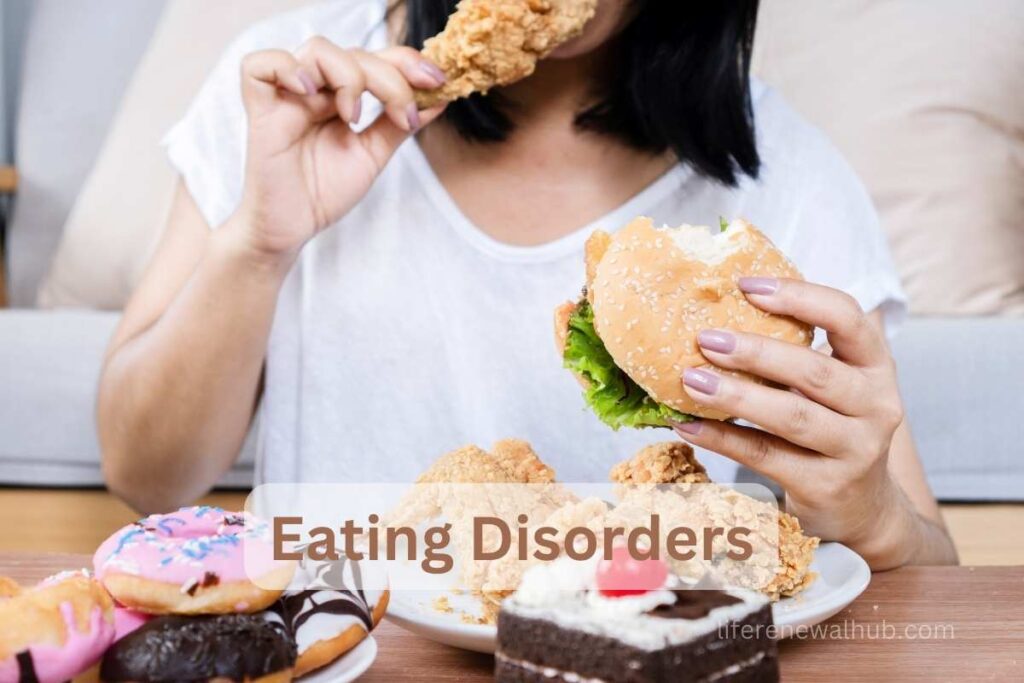Eating disorders are complex mental health conditions characterized by abnormal eating habits that can negatively impact physical and emotional health. This guide explores the different types of eating disorders, their symptoms, causes, and the most effective nutritional interventions.

Understanding Eating Disorders
Types of Eating Disorders
- Anorexia Nervosa
- Characteristics: Severe restriction of food intake, intense fear of gaining weight, distorted body image.
- Health Risks: Malnutrition, bone density loss, heart complications, and severe electrolyte imbalances.
- Bulimia Nervosa
- Characteristics: Binge eating followed by purging (vomiting, excessive exercise, or laxative use).
- Health Risks: Electrolyte imbalance, gastrointestinal problems, dental issues, and severe dehydration.
- Binge Eating Disorder (BED)
- Characteristics: Consuming large quantities of food in a short period, often without hunger, followed by feelings of shame or guilt.
- Health Risks: Obesity, type 2 diabetes, cardiovascular diseases, and psychological distress.
- Other Specified Feeding or Eating Disorders (OSFED)
- Characteristics: Symptoms of disordered eating that do not meet the criteria for the above disorders but are still significant and require treatment.
- Health Risks: Vary depending on specific behaviors but can include many risks associated with anorexia, bulimia, and BED.
Causes and Risk Factors
- Genetic Factors: Family history of eating disorders or other mental health conditions.
- Psychological Factors: Low self-esteem, perfectionism, anxiety, and depression.
- Sociocultural Factors: Cultural pressure to be thin, societal beauty standards, and exposure to media promoting unrealistic body images.
- Biological Factors: Hormonal imbalances and nutritional deficiencies can contribute to the development of eating disorders.
Nutritional Interventions for Eating Disorders
Effective nutritional interventions are a crucial component of treating eating disorders, often involving a multidisciplinary approach that includes dietitians, therapists, and medical professionals.
Anorexia Nervosa Interventions
- Nutritional Rehabilitation: Gradually increasing calorie intake to restore healthy body weight.
- Balanced Meal Plans: Developing structured meal plans that ensure adequate nutrient intake.
- Monitoring and Support: Regular monitoring of weight, nutritional intake, and physical health, along with psychological support to address body image issues.
Bulimia Nervosa Interventions
- Regular Eating Patterns: Establishing a consistent meal schedule to prevent binging.
- Nutritional Education: Educating about balanced diets and the dangers of purging behaviors.
- Psychological Therapy: Cognitive-behavioral therapy (CBT) to address underlying psychological issues and develop healthy coping mechanisms.
Binge Eating Disorder Interventions
- Portion Control: Teaching portion control and mindful eating practices.
- Healthy Food Choices: Encouraging the consumption of nutritious foods to improve overall health.
- Behavioral Therapy: CBT and other therapeutic approaches to address emotional triggers for binge eating.
More Like This Optimizing Nutrition for Aging Populations: A Comprehensive Guide
General Nutritional Strategies
- Individualized Meal Plans: Tailoring meal plans to individual needs, preferences, and cultural backgrounds.
- Nutritional Supplements: Addressing deficiencies with appropriate supplements under professional guidance.
- Ongoing Monitoring: Regular follow-ups to adjust meal plans and ensure sustained recovery.
Conclusion
Eating disorders require comprehensive treatment strategies that address both the psychological and nutritional aspects of the condition. Early intervention, continuous support, and personalized nutritional plans are vital in promoting recovery and preventing relapse. If you or someone you know is struggling with an eating disorder, seeking professional help is the first step towards healing and recovery.
For further reading and support, consider consulting resources from reputable organizations such as the National Eating Disorders Association (NEDA), the Academy for Eating Disorders (AED), and the World Health Organization (WHO).
The most common types of eating disorders are Anorexia Nervosa, Bulimia Nervosa, Binge Eating Disorder (BED), and Other Specified Feeding or Eating Disorders (OSFED).
Eating disorders can be caused by a combination of genetic, psychological, sociocultural, and biological factors. These include family history, low self-esteem, societal beauty standards, hormonal imbalances, and nutritional deficiencies.
Nutritional interventions help by restoring healthy eating patterns, addressing nutritional deficiencies, and supporting overall physical and mental health. These interventions are often part of a multidisciplinary treatment approach.
Specific interventions for Anorexia Nervosa include nutritional rehabilitation, balanced meal plans, and regular monitoring with psychological support to address body image issues.
Nutritional treatment for Bulimia Nervosa involves establishing regular eating patterns, providing nutritional education, and combining these with psychological therapies such as cognitive-behavioral therapy (CBT).
